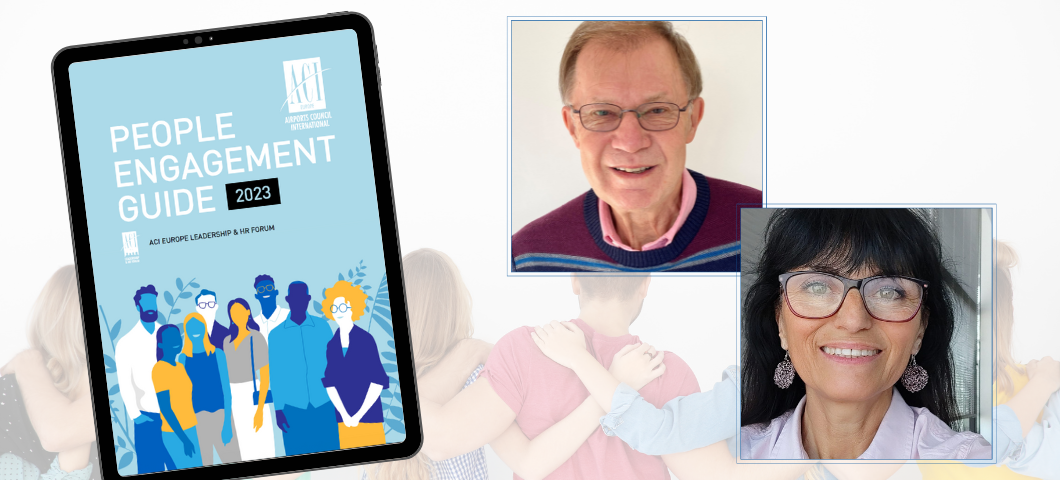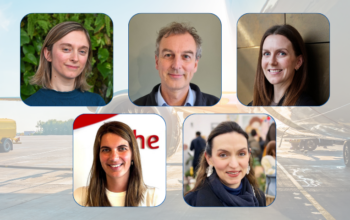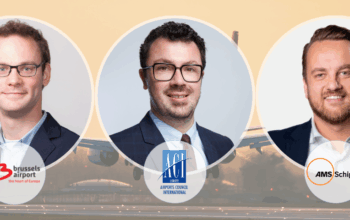
From airport ‘workers’ to airport ‘ambassadors’ – A new ACI EUROPE guide to engaging airport workforce is out
The Five Minute Feature has an HR cap on this time around. We are bringing you an interview with the authors of the ACI EUROPE People Engagement Guide, a brand new guidance document laying out the way for airport leaders to enhance and upgrade their HR practices to attract the workforce of the future and create a positive work environment at airports.
Dr Richard Plenty and Dr Pepina Miteva are both experienced human resources leaders and organisational consultants. As such, they were the core authors of the Guide, with input from the ACI EUROPE Leadership & HR Forum.
What is the People Engagement Guide and who was it written for?
The People Engagement Guide aims to provide a practical, easy to follow and implementable approach to understanding and addressing people engagement in airports. It does so by focusing on how to create the kind of positive, inclusive, people-oriented environment that can help all those who work for airports to feel motivated and enthusiastic about both their organisations and the work they do. It brings together findings from research, best practice and the collective practical experience of European airports.
The guide is primarily targeted at airport leaders – CEOs, airport management, line managers and HR professionals – who have the primary responsibility for shaping airport culture. However, it is relevant to all those who contribute to creating a positive work environment and atmosphere at airports, including service companies, contractors and, of course, employees themselves.
Why is People Engagement especially important now?
Attracting people back to a sector which was so recently struggling to survive – and released many of its people during the pandemic – is proving to be a formidable challenge. As demand for travel continues to grow, retaining those who work in airports is also a priority. Now is therefore an ideal opportunity for airport leaders to reflect on the way they treat their people and whether they provide the kind of people-centred environment which will attract and retain the best talent. This means making People Engagement a leadership priority.
Creating an organisation culture which pays attention to improving the passenger experience is also critical. Throughout their journey, passengers encounter people working in airports whose attitude and approach play a key role in their experience. To do this really well means that airport ‘workers’ have to be airport ‘ambassadors’, passionate about their work, prepared to go the extra mile, and with a sense of emotional commitment to their airport and its purpose. The foundation for this is people engagement.
What are the benefits of moving from Human Resources Management to People Management?
The advantage of the people-centred approach described in the guide is that it helps build trust and creates an organisation culture where cooperation rather than conflict is the norm, providing the foundation for the kind of people strategy most likely to create a motivated work force.
The traditional ‘Human Resources Management’ approach which views people as company assets provides a solid foundation for the basic people necessities – for example pay, conditions and resource planning – but is not enough to build people engagement.
A ‘People Management’ approach treats people as individuals rather than simply business resources, ensuring they are treated fairly as ‘partners’ in the enterprise and focusing on how to improve their experience at work. It is about listening, sharing best practice, inclusivity, investing in knowledge and skills, providing career opportunities, communication and dialogue – and improving life and experience within the organisation and beyond.
Paying attention to people’s needs, expectations and emotions can make a real difference to how people think and feel about themselves, their work, their colleagues and their organisation. They are more likely to be enthusiastic about what they are doing, feel a heightened sense of intellectual and emotional connection, and be prepared to go ‘above and beyond’ the formal requirements of their role description to get the work done and do the right thing.
Is People Engagement a crucial factor for airports to be able to attract workforce in the future and keep their attractiveness as employers?
We believe that People Engagement has not been given sufficient attention in the past. It means creating a culture with meaning, clear values and strategy; an organised safe immediate work environment with the right equipment and technology; leadership which communicates, explains and listens; and providing opportunities for employee growth, learning and development. It also means providing a degree of flexibility where possible. These are all areas which generally have an impact on attraction and retention.
For any particular airport, it is important to focus on one or two key areas for improvement. To do this properly means bringing together the evidence from employee surveys, focus groups and interviews, and people metrics such as turnover – and reviewing this in the context of business strategy and objectives.
For the airport sector as a whole, it may also be important to look anew at the basics – pay, conditions and overall prospects – to ensure these remain competitive, as well as communicating what airports are doing to create a sustainable environment.
If you could choose one message from the Guide for readers to take away and remember, what would it be?
Creating a people-centred environment should be a priority across the whole airport sector and is a key responsibility of airport leadership.
Download your copy of the ACI EUROPE People Engagement Guide here.
Dr. Richard Plenty is Managing Director of This Is. He is an experienced international organisation development consultant, human resources leader and business psychologist. He works with leaders and top teams on issues associated with leadership, strategic change, organisation culture, and talent management and organisation effectiveness. His style is strategic, engaging and business focused.
Dr. Pepina Miteva has more than 20 years’ experience in the HR field, 13 of which as a Head of Human resources at Fraport Bulgaria (operator of Varna and Burgas airports). Her professional experience covers development and establishment of the whole range of airport HR activities, including organisational design, HR strategy, recruitment, staff administration, training, career development, recognition and rewarding, staff wellbeing, etc. She has an exceptional experience as a trainer in HR and soft skills and experience in international aviation projects as HR Expert, ORAT HR consultant and ORAT Training manager worldwide.



